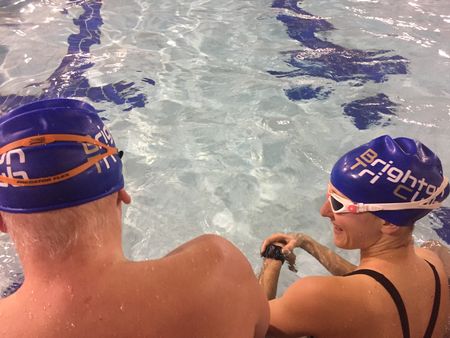Beth’s tips for sea swimming in Brighton
/Having worked several summers as a beach lifeguard in Brighton, our very own Bethan Male kindly shares her tip-top local knowledge, giving you top tips for the best sea swimming experience.
Tip 1)
When possible, swim off a lifeguarded beach. This means we can keep an eye on you and give you somewhere to leave your stuff (as long as you ask us nicely).
The link below details where all the lifeguarded beaches are and when they are open. As well as marking the lifeguarded swim area, the (round yellow) buoys also mark where motorised craft are not allowed, so it’s much safer to swim within this area. Lifeguard details: https://www.brighton-hove.gov.uk/libraries-leisure-and-arts/seafront/lifeguards?language=bsl
If we are flying red flags, this is because we do not think it is safe to swim. If you see red flags flying, come and chat to the lifeguard – the reason for this varies from bad water quality to fog affecting our vision, to stormy/challenging sea conditions.
Outside of Brighton, lifeguarded swim areas are marked with red and yellow flags.
Tip 2)
If you get into trouble, float on your back, put your arm up in the air, and the lifeguard will see you and help you.
If you are not in a lifeguarded area, lie on your back and rest – try not to panic and, if possible, slowly make your way back to shore. Nothing wrong with a bit of slow head-up breaststroke to get you into shore.
Tip 3)
Ideally, swim with a bright coloured cap and consider a tow float as this makes it much easier for us to see you when you swim out around the buoys!
Tip 4)
If you are a less confident swimmer or not swimming on a lifeguarded beach, swim along the coast rather than out to sea/around the buoys. That way, if you get into trouble, you can quickly get out of the water. While the buoys make a good target and sighting practice, they are a long way out to sea if you get into trouble.
If possible, swim with a friend and/or make sure someone knows where you are swimming and when you should be back. If you get into trouble, they can call the coastguard on 999.
Tip 5)
Wetsuits and water temperature.
The summer sea temperature is approx. 15-19°C. However, this is warm enough to swim without a wetsuit.
If you plan to swim without a wetsuit, start with short swims, allowing your body to acclimate to the cold.
Consider other benefits of the wetsuit – the buoyancy makes swimming easier and helps you float if you become tired. You will probably be racing in a wetsuit, so it makes sense to practise in it.
Tip 6)
Check the weather and surf forecast before coming down to the beach.
I would use the Met Office for the weather - https://www.metoffice.gov.uk/public/weather/forecast/gcpchgv78#?date=2018-07-14
And Magicseaweed for the Surf Forecast - https://magicseaweed.com/Brighton-West-Pier-Surf-Report/15/
Generally, offshore (northerly) wind means a calm flat sea and ideal swimming conditions. Onshore (southerly) wind creates more chop. The windier it is, the bigger the waves (i.e. big southwesterly storm = big waves and ‘shore dump’ as well as a very strong current west to east).
Tip 7)
Check and understand the tide times and what they mean.
You can also do this on Magicseaweed https://magicseaweed.com/Brighton-West-Pier-Surf-Report/15/
As a general rule, when the tide is going out, the current will pull east to west, and when the tide is coming in, the current will pull west to east. Currents change and are strongest around 30-60 minutes before the tide changes (pulling in the direction it is about to change to) but vary in strength depending on the size of the tide.
We have spring (large) tides and neap (small) tides, which are determined by the moon. The current will be stronger during a spring tide due to the greater water movement. At its strongest, this current is tough to swim against, so plan the timing of your swim.
This current isn’t dangerous as it will only pull you along, not out to sea. However, it can become dangerous if you try to fight it – if you are not making progress, there is no shame in swimming into shore and walking back! (It happens to the best of us).
If you are unsure of the tide/current, ask the lifeguard, and they can advise you.
Tip 8)
Rip currents
In Brighton, we don’t really have any dangerous rip currents that would take you out to sea; however, elsewhere in the UK, this is not the case.
However, we often get small rip currents around groynes and other objects sticking out to sea, which threaten children and non-swimmers.
Dangerous rip currents are, however, very common elsewhere in the UK. Before swimming in an unknown body of water, try to find some local knowledge beforehand. Here is some advice from the RNLI for if you do find yourself in a rip current:
Rip currents are a major cause of accidental drowning worldwide and the top environmental cause of our lifeguard incidents. So, what are rips, how can you spot them and - if you ever find yourself caught in one - what can you do?
Rips are powerful currents caused by waves breaking on shallow sandbars and pushing water back to sea through deeper channels. Sandbars are submerged or partly exposed ridges of sand that are built up by the action of tides and waves.
People can easily get caught out by rip currents because, to an untrained eye, they can look like a calmer place to enter the water.
There are several indicators of rip currents that you can look out for:
• darker patches in the water beside shallower sandbars
• rippled or churned water without breaking waves (as shown in the centre of the photo above)
• formation of foam
• bits of debris floating out to sea
• and discoloured brown water where the sand beneath has been disturbed.
Five steps to escaping rip currents
1. Avoid them, where possible
Always swim between the flags and on lifeguarded beaches. Flags are marked based on where it is safer to swim in the present conditions.
2. Alert others
If you’re struggling in a rip current, always raise your hand and shout for help. Even if you can get out of it, it pays to have others ready to help.
Keep hold of anything that floats, such as a bodyboard or surfboard.
3. Don’t exhaust yourself
If you try to swim against the force of a rip, you’ll lose energy very quickly. Stay calm and float to assess the situation.
4. How deep is the water?
If you can stand, wade out of the current, don’t swim. Rips can flow at 4-5mph, which is faster than an Olympic swimmer!
5. Swim parallel
If the water is too deep to stand, and you can swim, swim across the direction of the current, parallel to the shore until you are free. Use any breaking waves to help you get back to the beach.
Relax and float for around 60-90 seconds if you need to catch your breath. Some rip currents recirculate rather than flow out to sea and may bring you closer to shore.




